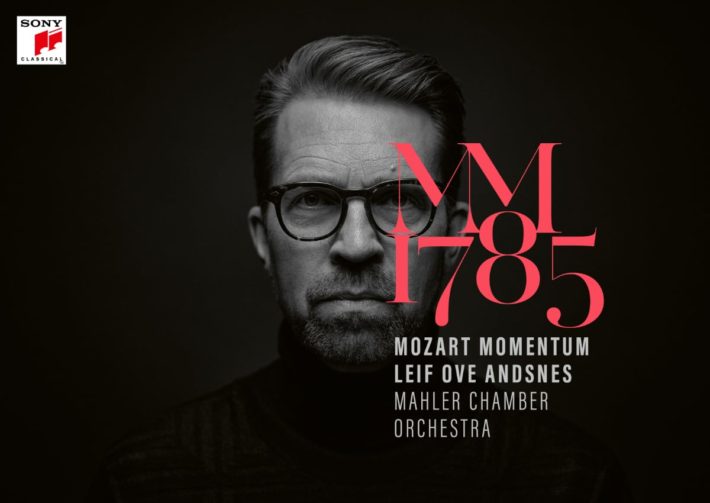On the tails of his acclaimed “Beethoven Journey”, which includes the five Piano Concertos and Choral Fantasy, Leif Ove Andsnes collaborates again with the Mahler Chamber Orchestra as conductor and soloist in “Mozart Momentum”, an ambitious four-year project that explores one of Mozart’s most productive eras. The first installment, 1785, features Concertos 20-22 among other works.
1785 was a time of change for Mozart’s piano concerti: a vehicle that formerly entertained now made a bold statement. K.466 is a perfect example: one of just two minor key concerti, it embodies the Sturm und Drang style and also breaks with tradition. In the Allegro (track 1), for instance, the soloist introduces material independent from that of the orchestral exposition. As for the performance, the ensemble emphasizes the triplet figures in the introduction, creating dramatic urgency while highlighting a gilding motif through a sizable exposition. The piano’s entrance is deceptively simple because the phrases are so terse; despite this, Andsnes creates a wistful, pleading line. The development sees the pianist creating vibrant transformations of the opening theme, imbuing each with its own color. And thanks to a well-crafted buildup of dynamics, soloist and ensemble work together to bring to the section a definitive architecture. As for the cadenza, Andsnes fittingly chooses Beethoven’s. Staying true to his style, we get a slight departure from Mozart – but this is not at all a bad thing.
The well-loved Romanze (track 2) is brisk, but Andsnes offers a rhythmic fluidity in the lyrical phrases, and with a silvery tone. He fills out some of the more open lines with some tasteful ornamentation but still lets us experience their simple beauty. If we revisit his older recording from 2000 with the Norwegian Chamber Orchestra, the tempo is fairly similar, but there seems to be more unrest in the presentation. I do prefer this newer version, with more nuance and phrases that have better closure.
Related Classical Music Reviews
- Review: “The Messenger” – Hélène Grimaud Plays Mozart and Silvestrov
- Review: Mozart – Violin Concertos – Christoph Koncz, Les Musiciens du Louvre
- Review: Mozart – Piano Concertos No. 19 and 27 – Piemontesi, Manze
The introduction of Piano Concerto K.482 is commanding in its pomp. We can really hear how Mozart expands orchestral sonorities: part of the grandness is also in an intricacy that blurs the distinction and hierarchy between primary and secondary voices. For instance, in the first movement (track 6, disc 2), the lyrical interludes at 0’04”-11” and 0’14”-21” show an even partnership between individual lines in the horns and bassoons, and again in the high winds and strings. As for Andsnes’ pristine piano lines, they reflect a thoughtful regard for overall cohesion. Some might look for a flashier virtuosity, but his level-headed stance works perfectly to bring out filigree textures without sounding cacophonous. It also contrasts nicely with the density of the orchestra’s recurring theme.
A pathos-laden Andante (disc 2, track 7) is followed by an optimistic Allegro, whose inviting piano theme beckons us to hum along; here, Andsnes’ sprightly pace adds an energetic yet elegant gallop. The orchestra assumes an early Beethovinian gusto; this symphonic spirit makes us forget that we’re actually listening to a chamber orchestra. Each of the unique episodes adds a wealth of characters to the movement, whose distinctions the performers capture masterfully. And as for comparisons, we have to include Alfred Brendel’s two versions, from 1975 with Sir Neville Marriner and 2000 with Sir Charles Mackerras. The cadenzas, of course, stand out: Andsnes opts for consistency with Geza Anda’s playful version while Brendel goes for contrast with his own minor-key one. Brendel’s stacccatos are drier on the whole and some of the runs are even a bit crisper. The timpani and bass sections in the 1975 album pack a little less punch but the 2000 one presents an orchestra in full force similar to Andsnes’ recording – and with particularly nice horn blasts.
The non-concerto works are all quite nice, but the Masonic Funeral Music (track 5, disc 2) is worth a mention. A dirge-like solemnity is interrupted by sudden dynamic shifts and piercing interjections by the brass – something that the ensemble does very well to heighten the work’s harrowing drama.
The sound engineering sets the soloist and ensemble on equal footing which helps highlight the complexity central to Mozart’s compositions at this time. The liner notes deftly synthesize musical analyses of each work into the 1785 framework.
This recording (especially of the concertos) holds its own against some fine versions out there, and sets expectations high for the second installment, “1786”, coming out this Fall. Recommended with utmost enthusiasm.

“Mozart Momentum 1785”
Mozart – Piano Concertos No. 20-22
Piano Quartet No. 1 in G Minor
Fantasie in C Minor
Masonic Funeral Music
Leif Ove Andsnes – Piano, conductor
Mahler Chamber Orchestra
Sony Classical, CD 19439742462
Recommended Comparisons
Read more classical music reviews or visit The Classic Review Amazon store
Follow Us and Comment:
[wd_hustle id=”HustlePostEmbed” type=”embedded”]











